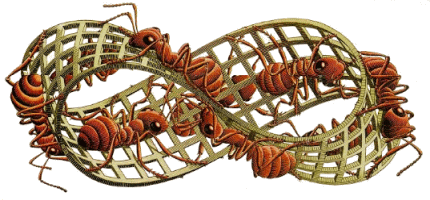 The Möbius strip is famous because it has only one side and one edge. If you were to trace both 'sides' of a Mobius strip, you would never have to lift your finger.  The properties of the strip were discovered independently by two German mathematicians, August Ferdinand Möbius and Johann Benedict Listing, in 1858. The properties of the strip were discovered independently by two German mathematicians, August Ferdinand Möbius and Johann Benedict Listing, in 1858.Möbius strips are used in conveyor belts and power take off belts because they allow the entire surface area of the belt to receive an equal amount of wear, which makes it last longer. They have also been used in continuous-loop recording tapes, typewriter ribbons and computer print cartridges.  On the left is M.C. Escher’s famous picture, Möbius Strip II (Red Ants)? It shows that ants could walk on a Möbius strip indefinitely. That may be why people connect the Möbius strip to the idea of infinity. It may also be why the symbol for infinity resembles a Möbius strip.  If you cut a Möbius strip down the center, along its full length, you're left with one larger loop with four half-twists. This leaves you with a twisted circular shape, but one that still has two sides. Cut that down the middle and, amazingly, you get two linked strips. Try it! Cutting a Möbius strip one third of the way in from the edge (and parallel to it) will produce two Möbius strips, looped together! Mobius, Moebius, or Möbius? August Ferdinand Möbius was German, and the 'o' in his name was really an umlaut , an 'o' with two dots above it, like this: ö. In English, some choose to spell this with an 'oe', to attempt to show a proper pronunciation, as in 'Moebius'. Others ignore it and write Mobius. |